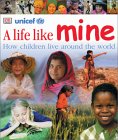 Book Reviews by Sondra Eklund
Book Reviews by Sondra Eklund

|

|
|
Nonfiction
Fiction Young Adult Fiction Children's Nonfiction Biography Previous Book Next Book Children's Fiction Picture Books 2004 Stand-outs Previous Book Next Book 2003 Stand-outs 2002 Stand-outs 2001 Stand-outs Five-Star Books Four-Star Books PreviousBook Next Book Old Favorites Back Issues List of Reviews by Title List of Reviews by Author Why Read? Children and Books Links For Book Lovers About Me Contact Me Subscribe Post on Bulletin Board View Bulletin Board I don't review books I don't like!
*****= An all-time favorite |

****A Life Like MineHow Children Live Around the World
Reviewed May 25, 2004.
DK Publishing, in association with UNICEF, New York, 2002. 128 pages. Available at Sembach Library (J 305.23 LIF). Sonderbooks Stand-out 2004, #8, Children's Nonfiction A Life Like Mine is a big, beautiful book, telling how children live all over the world. It breaks their stories into four sections—Survival, Development, Protection, and Participation. Under Survival, it tells us that every child should have water, food, a home, and a healthy life. We hear stories and see pictures of different children in different countries. Some get their water from a town pump, some carry water on their heads. It shows the many different kinds of food that children from different countries eat. In the section on Development, we’re told that every child has the right to education and somewhere safe to play. A graph made of children with piles of books presents the different percentages of girls and boys who go to school in different parts of the world. We also see many different forms that play can take. Next, the book talks about Protection. Every child should have someone to love and care for them, should be protected from work that could harm or exploit them, should not be prevented from a full life by disability, and need protection from the fighting and destruction of war. Despite these serious topics, the book looks on the bright side, for example showing a boy in Bangladesh who got to leave a difficult job and become a television reporter. It also shows children in a UN recovery camp for former child soldiers in Sudan and Rwanda. The final section is about Participation, that every child has a right to an identity, including a name, nationality, and religion. Every child has the right to freedom of expression and a good life. Again, the focus is on the positive, looking at children who have these things, though mentioning that sometimes people try to take them away. This book is wonderful to look at, with photos of children from all over the world as the main illustrations. It’s also full of fascinating facts. Having just read Iqbal about child labor in Pakistan, and how organizations like UNICEF helped change that, the book hit me especially hard. Again, it’s all done beautifully, with the focus on the positive, but it does make you want to help see that children get these things that, indeed, every child should have, and it makes you more aware that there are children in the world who don’t get them. Copyright © 2005 Sondra Eklund. All
rights
reserved. |